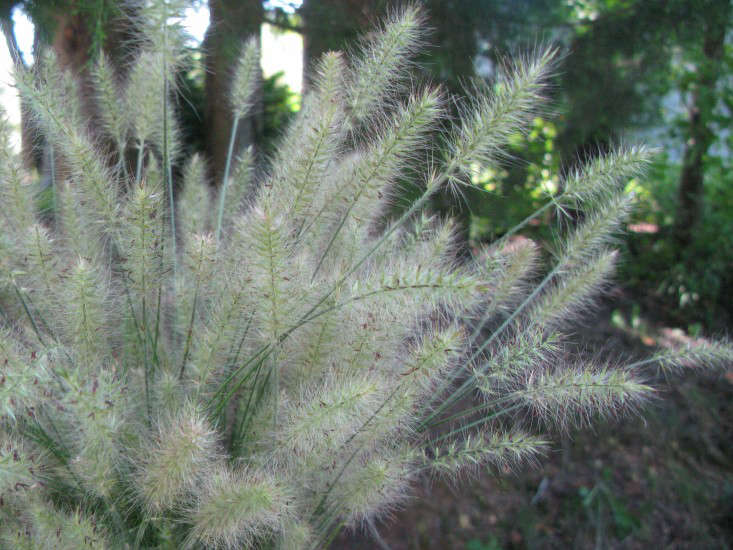Fountain Grass, Pennisetum: “Whatever Works”
In every garden, as in every life, there are those easy-going players that make things a bit more relaxed for everyone. Give them a drink when they first arrive, offer a no-fuss chair, and they’re happy. That’s pennisetum, also known as fountain grass. It settles in quickly and will bring no-work color, structure, and texture to a space almost immediately.
Photography courtesy of Hoffman Nursery, except where noted.
Above: With P. alopecuroides ‘Hameln’ in the foreground, fountain grasses frame a landscape by Stephen Stimson Associates Landscape Architects. Photograph by Charles Mayer.
From the Latin penna (feather) and seta (bristle), pennisetum cultivars have fine, hair-like inflorescences, or plumes. But don’t be fooled by the apparent delicacy—these grasses are a tough but flexible bunch. Most of the 130-plus species grow in flowering, fountain shapes with plumes of cream, tan, pink, or burgundy. Often their foliages change color in fall. Native to tropical, subtropical and warm, temperate regions, pennisetum grasses thrive in sun and heat and require little maintenance or water once established. They’re used as annuals in colder climates.
Above: ‘Hameln’ is the oldest cultivar of P. alopecuroides and is popular in gardens with a short growing season because of its early bloom. It grows to 2 feet and is considered a dwarf fountain grass, making it perfect for gardens and containers alike.
Above: Pennisetum grasses look beautiful en masse or alone. “Whatever works” is their motto. In a Cape Town garden, designer Franchesca Watson pairs fountain grasses with (in the foreground) clumps of Carex evergold. For more, see Garden Designer Visit: A Study in Green. Photograph courtesy of Franchesca Watson.
Above: Pennisetum seeds are stored in the plumes. Plumes can be feathery or compact. The grasses have a clumping growth habit and are spread through seed or underground rhizomes. Above: P. alopecuroides ‘Red Head’ attracts flying insects.
Cheat Sheet
- In Africa, the leaves of several pennisetum species are woven into baskets or sieves or are used as animal feed. Pearl millet (P. glaucum) has fed people in Africa and India for thousands of years.
- Pennisetum plumes go either way—dried or fresh, they’re perfect for floral arrangements.
- P. clandestinum, otherwise known as kikuyu grass, is a tough, invasive species that spreads by rhizomes. The famed Riviera Country Club and Torrey Pines Golf Course both use it on their fairways.
Above: P. setaceum ‘Fireworks’ adds pop with variegation and bold color.
Keep It Alive
- Variegated or purple-foliaged pennisetum grasses are often tender in all but the warmest climates. Because of this they’re usually treated as annuals in colder regions.
- Though very adaptable, pennisetum generally like well-drained soil and full sun. Some varieties do kick back in the shade.
- If you are inclined to shear this low-maintenance plant, cut it back in the early spring and divide in late spring or early fall.
Above: Pennisetum grasses are a perfect choice when looking for texture, delicate contrast and movement. Here they interplay with sedum, salvia, and eutrochium (Joe-Pye weed).

Above: P. alopecuroides ‘Red Head’ mingle in a crowd. For more information about ornamental and native grasses, see Hoffman Nursery (which is a to-the-trade-only nursery).
Adding grasses to your landscape? For inspiration, see Leaves of Grass: 9 Ways to Create Curb Appeal and Pink Grasses: 11 Ideas for Muhlenbergia in a Landscape.
N.B.: Looking for inspiring images and ideas to create a new garden? See our field guides:
- Hardscape 101 will help turn your dreams into a firm plan.
- For planning, care & design, see our Garden Design 101 field guides.
- Looking for a grass that’s another favorite of garden designers? Consider Muhly Grass 101.
Finally, get more ideas on how to plant, grow and care for various grasses with our Grasses: A Field Guide.
Additionally, get more ideas on how to successfully plant, grow, and care for fountain grass with our Fountain Grass: A Field Guide.














Have a Question or Comment About This Post?
Join the conversation